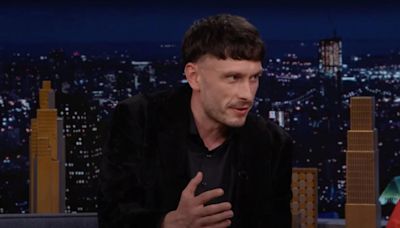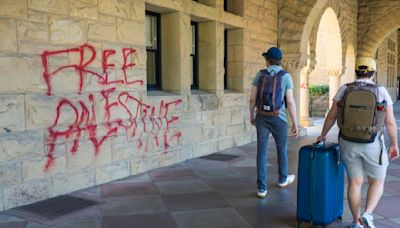Search results
- Trailers & Clips
Browse sermons and series from The Crossing, join the online worship experience, download the app, and more.
- Sermon Archive
The Crossing is a multi-campus, non-denominational church...
- Romans 6
Romans 6 explores the concept of crossing a line and the...
- Sermon Archive
The Crossing Church. Find times, locations and more info at: http://wearecrossing.com Follow us on social media at: Instagram https://instagram.com/wearecrossing Twitter...
- Overview
- Taking back time
- Expanded temporal experience
- Religious symbolism
- Technological experimentation
- Sacred space
By Dr. Allison Young
"We have to reclaim time itself, wrenching it from the 'time is money' maximum efficiency, and make room for it to flow the other way—towards us. We must take time back into ourselves to let our consciousness breathe and our cluttered minds be still and silent. This is what art can do and what museums can be in today’s world."
Bill Viola’s The Crossing is a room-sized video installation that comprises a large two-sided screen onto which a pair of video sequences is simultaneously projected. They each open in the same fashion: a male figure walks slowly towards the camera, his body dramatically lit from above so that it appears to glow against the video’s stark-black background. After several minutes he pauses near the foreground and stands still. He faces forward, staring directly into the lens, motionless.
At this point the two scenes diverge; in one, a small fire alights below the figure’s feet. It spreads over his legs and torso and eventually engulfs his whole body in flames; yet, he stands calm and completely still as his body is immolated, only moving to raise his arms slightly before his body disappears in an inferno of roaring flames. On the opposite screen, the event transpires not with fire but with water. Beginning as a light rainfall, the sporadic drops that shower the figure build up to a surging cascade of water until it subsumes him entirely. After the flames and the torrent of water eventually retreat, the figure has vanished entirely from each scene, and the camera witnesses a silent and empty denouement.
The Crossing makes use of Viola’s signature manipulation of filmic time. Like many of the artist’s recent works, it was shot using high-speed film capable of registering 300 frames per second, thus attaining a much greater level of detail than would be discerned by the naked eye. In postproduction, Viola reduces the speed of playback to an extreme slow motion—further enhancing the level of definition to a dramatic and scrutinizing effect.
However, it is not only an interest in technological experimentation that drives the artist’s technical and aesthetic decisions. Viola’s use of slow-motion is meant to invite a meditative and contemplative response, one that requires the viewer to concentrate for a longer duration of time and simultaneously to increase his or her own awareness of detail, movement, and change. This is consistent with the artist’s intent to reignite the longstanding relationship between artistic and spiritual experience. A devoted practitioner of
The Crossing might be interpreted through the lens of mythology or religious thought, even though the work does not make iconographic or stylistic reference to a particular narrative. Viola has been inspired by a rich variety of spiritual traditions, including Catholicism, Hinduism, Buddhism, and
. Viewers may recall, for instance, the ring of flames that surrounds images of Shiva Nataraja in which he sets in motion the continuous cycles of creation and destruction through his cosmic dance, or the biblical tales of fire and brimstone, rapture and the Great Floods. Throughout such narratives, the elemental forces of fire and water often symbolize change, redemption, transformation, and renewal—common themes in Viola’s oeuvre. The artist has similarly made reference to transitions and passages in works such as The Passing, a 1991 video made shortly after his mother’s death, or Two Women, a 2008 piece in which figures slowly move through a translucent and symbolic barrier of water.
As early as the 1970s, Viola was one of the first visual artists to make use of new video technologies. As a student he experimented enthusiastically with new portable recording devices, with which he created short video performances that explored a variety of gestures, sounds, and expressions. During the 1970s and 1980s, he was artist-in-residence...
Between 1974 and 1976, Viola lived in Italy, where religious paintings and sculptures are often displayed in-situ, in the cathedrals for which they were commissioned. The continuing integration of historical art into contemporary public and religious life inspired Viola to design installations that mimicked the forms of devotional paintings, diptychs, predellas, and altarpieces—formats that encourage intimate contemplation of religious icons. Later traveling throughout Japan and other parts of East Asia, Viola observed the same active level of engagement with art. In Tokyo, for instance, he witnessed museum visitors placing offerings at the feet of sculptural
or other religious statuary.
For viewers, the experience of viewing Viola’s works need not be spiritually inscribed. In many cases, his works appeal to or reflect raw human emotions (the theme of his acclaimed exhibition The Passions) or universal life experiences. While The Crossing can be interpreted in light of a host of religious associations, the act of “self-annihilation” represented in the figure’s disappearance at each conclusion also serves as a metaphor for the destruction of the ego. In the artist’s words, this action “becomes a necessary means to transcendence and liberation,” especially in the face of life’s inevitable unpredictability. [4]
Notes:
[1] Bill Viola, as quoted in Buddha Mind in Contemporary Art, Jacquelynn Baas and Mary Jane Jacob, eds. (Berkeley: University of California Press, 2004), p. 254.
[2] Bill Viola, Buddha Mind, p. 254.
The Crossing - watch online: streaming, buy or rent. You are able to buy "The Crossing" on Apple TV, Vudu, Amazon Video, Google Play Movies as download.
- (226)
- 1
- TV-PG
- 7
The Crossing: Created by Jay Beattie, Dan Dworkin. With Steve Zahn, Natalie Martinez, Tommy Bastow, Rob Campbell. Refugees from a war-torn country 180 years in the future start showing up in the present to seek asylum in an American town.
- (10K)
- 2018-03-19
- Adventure, Drama, Sci-Fi
- 42
1.7K subscribers ‧ 417 videos. Located in Costa Mesa, CA, The Crossing is a church for people from all walks of life and backgrounds. You don’t need to know anything about God, the Bible ...
People also ask
Where can I watch 'the crossing'?
How was the crossing filmed?
What is the movie The Crossing about?
Who is the crossing?
Season 1. Small town on Oregon coast. Refugees wash up on beach. 204 IMDb 7.1 2018 12 episodes. X-Ray 16+. Science Fiction · Drama · Adventure. Available to buy. Buy Episode 1. $2.99. Buy Season 1. $22.39. More purchase. options. Save on each episode with a TV Season Pass. Get current episodes now and future ones when available. Learn more.




